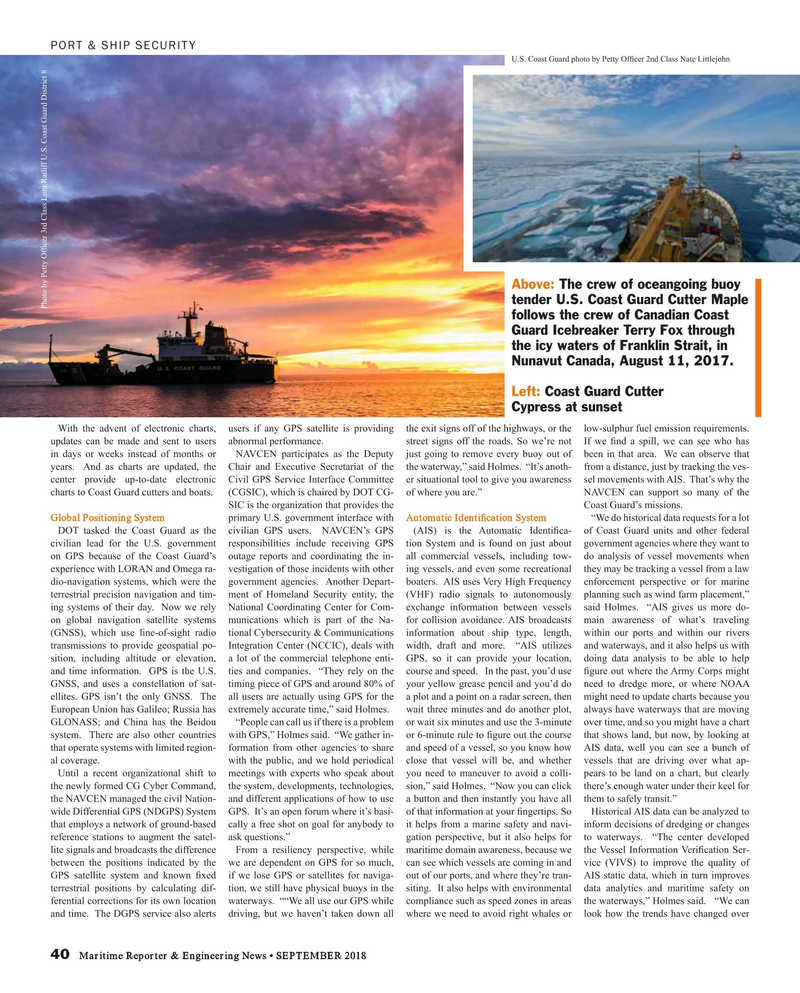
Page 40: of Maritime Reporter Magazine (September 2018)
Maritime Port & Ship Security
Read this page in Pdf, Flash or Html5 edition of September 2018 Maritime Reporter Magazine
PORT & SHIP SECURITY
U.S. Coast Guard photo by Petty Of? cer 2nd Class Nate Littlejohn
Above: The crew of oceangoing buoy tender U.S. Coast Guard Cutter Maple
Photo by Petty Of? cer 3rd Class Lora Ratliff U.S. Coast Guard District 8 follows the crew of Canadian Coast
Guard Icebreaker Terry Fox through the icy waters of Franklin Strait, in
Nunavut Canada, August 11, 2017.
Left: Coast Guard Cutter
Cypress at sunset
With the advent of electronic charts, users if any GPS satellite is providing the exit signs off of the highways, or the low-sulphur fuel emission requirements. updates can be made and sent to users abnormal performance. street signs off the roads. So we’re not If we ? nd a spill, we can see who has in days or weeks instead of months or NAVCEN participates as the Deputy just going to remove every buoy out of been in that area. We can observe that years. And as charts are updated, the Chair and Executive Secretariat of the the waterway,” said Holmes. “It’s anoth- from a distance, just by tracking the ves- center provide up-to-date electronic Civil GPS Service Interface Committee er situational tool to give you awareness sel movements with AIS. That’s why the charts to Coast Guard cutters and boats. (CGSIC), which is chaired by DOT CG- of where you are.” NAVCEN can support so many of the
SIC is the organization that provides the Coast Guard’s missions.
Global Positioning System primary U.S. government interface with Automatic Identi? cation System “We do historical data requests for a lot
DOT tasked the Coast Guard as the civilian GPS users. NAVCEN’s GPS (AIS) is the Automatic Identi? ca- of Coast Guard units and other federal civilian lead for the U.S. government responsibilities include receiving GPS tion System and is found on just about government agencies where they want to on GPS because of the Coast Guard’s outage reports and coordinating the in- all commercial vessels, including tow- do analysis of vessel movements when experience with LORAN and Omega ra- vestigation of those incidents with other ing vessels, and even some recreational they may be tracking a vessel from a law dio-navigation systems, which were the government agencies. Another Depart- boaters. AIS uses Very High Frequency enforcement perspective or for marine terrestrial precision navigation and tim- ment of Homeland Security entity, the (VHF) radio signals to autonomously planning such as wind farm placement,” ing systems of their day. Now we rely National Coordinating Center for Com- exchange information between vessels said Holmes. “AIS gives us more do- on global navigation satellite systems munications which is part of the Na- for collision avoidance. AIS broadcasts main awareness of what’s traveling (GNSS), which use line-of-sight radio tional Cybersecurity & Communications information about ship type, length, within our ports and within our rivers transmissions to provide geospatial po- Integration Center (NCCIC), deals with width, draft and more. “AIS utilizes and waterways, and it also helps us with sition, including altitude or elevation, a lot of the commercial telephone enti- GPS, so it can provide your location, doing data analysis to be able to help and time information. GPS is the U.S. ties and companies. “They rely on the course and speed. In the past, you’d use ? gure out where the Army Corps might
GNSS, and uses a constellation of sat- timing piece of GPS and around 80% of your yellow grease pencil and you’d do need to dredge more, or where NOAA ellites. GPS isn’t the only GNSS. The all users are actually using GPS for the a plot and a point on a radar screen, then might need to update charts because you
European Union has Galileo; Russia has extremely accurate time,” said Holmes. wait three minutes and do another plot, always have waterways that are moving
GLONASS; and China has the Beidou “People can call us if there is a problem or wait six minutes and use the 3-minute over time, and so you might have a chart system. There are also other countries with GPS,” Holmes said. “We gather in- or 6-minute rule to ? gure out the course that shows land, but now, by looking at that operate systems with limited region- formation from other agencies to share and speed of a vessel, so you know how AIS data, well you can see a bunch of al coverage. with the public, and we hold periodical close that vessel will be, and whether vessels that are driving over what ap-
Until a recent organizational shift to meetings with experts who speak about you need to maneuver to avoid a colli- pears to be land on a chart, but clearly the newly formed CG Cyber Command, the system, developments, technologies, sion,” said Holmes. “Now you can click there’s enough water under their keel for the NAVCEN managed the civil Nation- and different applications of how to use a button and then instantly you have all them to safely transit.” wide Differential GPS (NDGPS) System GPS. It’s an open forum where it’s basi- of that information at your ? ngertips. So Historical AIS data can be analyzed to that employs a network of ground-based cally a free shot on goal for anybody to it helps from a marine safety and navi- inform decisions of dredging or changes reference stations to augment the satel- ask questions.” gation perspective, but it also helps for to waterways. “The center developed lite signals and broadcasts the difference From a resiliency perspective, while maritime domain awareness, because we the Vessel Information Veri? cation Ser- between the positions indicated by the we are dependent on GPS for so much, can see which vessels are coming in and vice (VIVS) to improve the quality of
GPS satellite system and known ? xed if we lose GPS or satellites for naviga- out of our ports, and where they’re tran- AIS static data, which in turn improves terrestrial positions by calculating dif- tion, we still have physical buoys in the siting. It also helps with environmental data analytics and maritime safety on ferential corrections for its own location waterways. ““We all use our GPS while compliance such as speed zones in areas the waterways,” Holmes said. “We can and time. The DGPS service also alerts driving, but we haven’t taken down all where we need to avoid right whales or look how the trends have changed over 40 Maritime Reporter & Engineering News • SEPTEMBER 2018
MR #9 (34-41).indd 40 MR #9 (34-41).indd 40 9/5/2018 11:46:16 AM9/5/2018 11:46:16 AM

 39
39

 41
41
